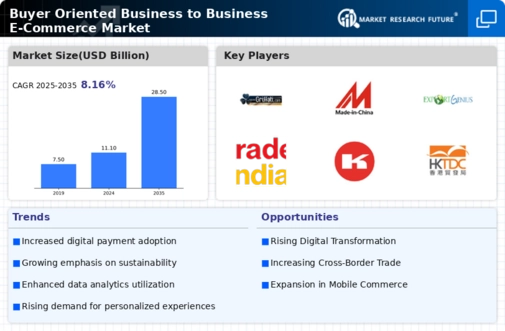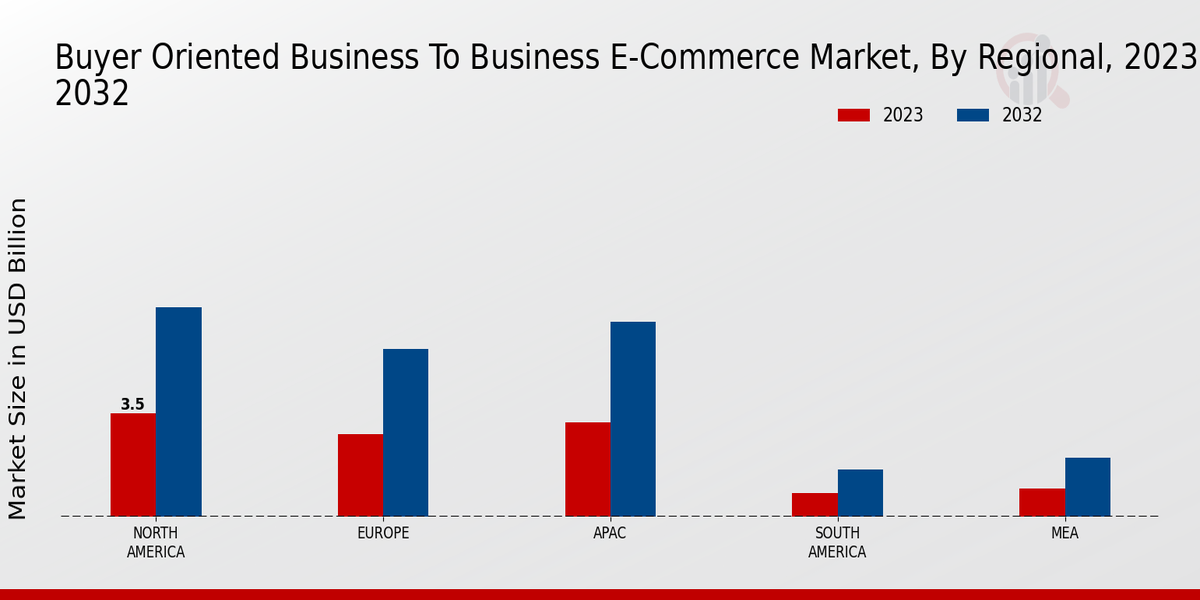Expansion of Global Trade
The Global Buyer Oriented Business to Business E-Commerce Market Industry is significantly influenced by the expansion of global trade, which facilitates cross-border transactions and broadens market access for businesses. As trade barriers diminish and logistics improve, companies are increasingly engaging in international e-commerce. This trend is particularly relevant for small and medium-sized enterprises that seek to reach global customers without substantial investment in physical infrastructure. The ability to tap into international markets not only enhances revenue potential but also diversifies risk. Consequently, the market is poised for growth, with projections indicating a compound annual growth rate of 8.93% from 2025 to 2035.
Market Growth Projections
The Global Buyer Oriented Business to Business E-Commerce Market Industry is on a trajectory of substantial growth, with projections indicating a market size of 11.1 USD Billion in 2024 and an anticipated increase to 28.5 USD Billion by 2035. This growth reflects a compound annual growth rate of 8.93% from 2025 to 2035, driven by various factors including technological advancements, changing buyer preferences, and the increasing importance of digital platforms in B2B transactions. The market's expansion is indicative of a broader shift towards e-commerce in the B2B sector, as businesses recognize the efficiency and cost-effectiveness of online transactions. This upward trend is likely to create new opportunities and challenges for stakeholders in the industry.
Rapid Digital Transformation
The Global Buyer Oriented Business to Business E-Commerce Market Industry is experiencing a rapid digital transformation, driven by advancements in technology and increased internet penetration. Businesses are increasingly adopting digital platforms to streamline their procurement processes and enhance operational efficiency. In 2024, the market is projected to reach 11.1 USD Billion, reflecting a growing preference for online transactions over traditional methods. This shift is evident in various sectors, including manufacturing and wholesale, where companies leverage e-commerce solutions to reduce costs and improve supply chain management. As digital tools become more sophisticated, the market is likely to expand further, indicating a robust trajectory for the coming years.
Emergence of Sustainable Practices
Sustainability is becoming a pivotal driver in the Global Buyer Oriented Business to Business E-Commerce Market Industry, as businesses increasingly recognize the importance of environmentally responsible practices. Companies are adopting sustainable sourcing, reducing waste, and implementing eco-friendly logistics solutions to appeal to environmentally conscious buyers. This shift is not only beneficial for the planet but also enhances brand reputation and customer loyalty. As sustainability becomes a core component of business strategy, it is expected to influence purchasing decisions significantly. The market's evolution towards sustainability may also align with the projected growth to 28.5 USD Billion by 2035, as more businesses seek to integrate these practices into their operations.
Integration of Advanced Technologies
The integration of advanced technologies such as artificial intelligence, machine learning, and blockchain is reshaping the Global Buyer Oriented Business to Business E-Commerce Market Industry. These technologies enable businesses to optimize their operations, enhance security, and improve decision-making processes. For instance, AI-driven analytics can provide insights into buyer behavior, allowing companies to tailor their offerings more effectively. Moreover, blockchain technology enhances transparency and trust in transactions, which is vital for B2B relationships. As these technologies become more prevalent, they are likely to drive efficiency and innovation within the market, contributing to its anticipated growth trajectory.
Increased Focus on Customer Experience
In the Global Buyer Oriented Business to Business E-Commerce Market Industry, there is a heightened emphasis on customer experience as businesses strive to differentiate themselves in a competitive landscape. Companies are investing in user-friendly interfaces, personalized services, and efficient customer support to enhance buyer satisfaction. This trend is particularly pronounced in sectors such as technology and retail, where customer expectations are evolving rapidly. By prioritizing customer experience, businesses can foster loyalty and repeat purchases, which are crucial for sustained growth. As the market evolves, it is anticipated that organizations will continue to innovate in this area, potentially contributing to the projected market growth to 28.5 USD Billion by 2035.














